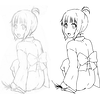モデル

提案モデルはすべての層が畳込み層のみから構成される多層ニューラルネットワークであり、ラフスケッチが入力されるとその線画が出力される。このモデルはdown-convolution, flat-convolution, up-convolutionの3種類の畳込み層から構成されている。down-convolutionではフィルタのストライド数を2にすることでマップの解像度を半分にし、flat-convolutionではマップの解像度は変えず、up-convolutionではストライド数を1/2にしてマップの解像度を2倍にしている。これにより、最初は画像を小さな特徴マップに圧縮して処理していき、最後に元の解像度に戻してきれいな線画を出力することができる。
結果

様々な種類のラフスケッチの線画化について実験を行い、良好な結果が得られることを示した。また、ユーザテストによって既存手法よりも良好な結果が得られていることを確認した。画像(a),(b),(d)はテストセットの一部であり、画像(c)と(e)はそれぞれFlickrユーザ”Anna Anjos”および”Yama Q”の作品をCreative Commonsライセンスのもとで使用している。
比較

既存のツールと提案手法の比較結果。ここでは、PotraceおよびAdobe Live Traceと比較している。提案手法は既存手法と比べ、自然な線画が生成されていることがわかる。
さらに詳しい内容については論文を参照。
本研究は一部 JST CREST の援助を受けている。


